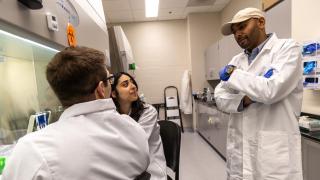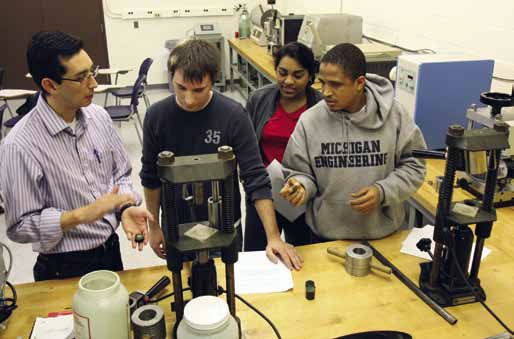
When mechanical engineering students returned to school this year, they had a nice surprise: four beautifully renovated labs in the College of Engineering and Computer Science. There was new tile, lighting, projectors, equipment and much more. Learning in the labs suddenly was a lot brighter, literally and figuratively.
The renovations were long overdue and greatly appreciated, according to Ben Li, professor and chair of the mechanical engineering department. "The faculty and students are excited about these changes. These labs hadn't been renovated in a long time. We really appreciate the university's commitment to updating our facilities like this."
The remodeling and new equipment cost about $350,000, Li said. Much of the funding was provided through the efforts of UM-Dearborn Provost Kate Davy. John Cherng, professor, and German Reyes-Villanueva, associate professor, took lead roles in coordinating this project.
"When I was appointed as the instructor responsible for teaching a core ME undergraduate course, it became clear to me that our students were missing the knowledge and hands-on experiences on current manufacturing processes that only an up-to-date lab environment could provide," says Reyes-Villanueva.
Cherng agrees. "The updated labs will allow for experiments to be conducted properly, not only enhancing students' understanding of the principles and theories that they have learned from lectures and textbooks, but also building up their expertise with instruments and sensors."
The four labs that were updated are:
- Manufacturing Processes Laboratory, used for teaching "Manufacturing Processes I"
- Ballistics and Blast Simulation Laboratory, used for research on impact dynamics
- Instrumentation and Measurement Laboratory, used for teaching "Instrumentation and Measurement Systems"
- Acoustics and Vibration Laboratory, used for teaching "Mechanical Vibration and Noise Control," "Mechanical Vibrations," and "Acoustics and Noise Control"
The floor tile, light fixtures, projectors and screens, and dry-erase wall boards were replaced in all of the labs. Other renovations included new ceilings, refinished hardwood lab benches, new desks and chairs, plumbing and electrical wiring, casework, and new sinks and counter tops.
The changes sound rather mundane, but the difference they make is, well, hard to measure, even in a laboratory.
"The incorporation of practical laboratory experiments allows students to discover by themselves the amazing relationships between basic principles, manufacturing processes, the effect of process parameters, and the performance of engineering materials," Reyes-Villanueva says.
"Important and practical knowledge will be gained by the students on heat treatments, metallography, mechanical properties, compression molding of composites, and powder metallurgy, among others."
"It's so much better to have laboratory layouts and larger space so we can have more students and more lab sections at the same time" adds Cherng. "Also, we can conduct demonstrations more effectively by using the new mounted projectors."
Edited and reprinted from Dearborn Engineer,the College of Engineering and Computer Science publication.





